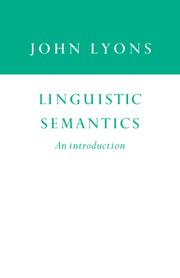Book contents
- Frontmatter
- Contents
- Preface
- List of symbols and typographical conventions
- Part 1 Setting the scene
- Part 2 Lexical meaning
- Part 3 Sentence-meaning
- 5 Meaningful and meaningless sentences
- 6 Sentence-meaning and propositional content
- 7 The formalization of sentence-meaning
- Part 4 Utterance-meaning
- Suggestions for further reading
- Bibliography
- Index
6 - Sentence-meaning and propositional content
Published online by Cambridge University Press: 05 June 2012
- Frontmatter
- Contents
- Preface
- List of symbols and typographical conventions
- Part 1 Setting the scene
- Part 2 Lexical meaning
- Part 3 Sentence-meaning
- 5 Meaningful and meaningless sentences
- 6 Sentence-meaning and propositional content
- 7 The formalization of sentence-meaning
- Part 4 Utterance-meaning
- Suggestions for further reading
- Bibliography
- Index
Summary
INTRODUCTION
This chapter is pivotal in the structure of the book. It is also one of the longest, and there is a distinct change of gear. We shall be making full use of logical notions and discussing in greater detail than we have done so far the basic concepts of modern formal, truth-conditional, semantics, which, as we saw in the preceding chapter, were first developed within logic and the philosophy of language and were subsequently extended to linguistics.
There is nothing new or revolutionary about the influence of logic on linguistics (and vice versa). Grammatical theory and logic have been closely associated for centuries. Indeed, much of the terminology of traditional grammar – ‘subject’, ‘predicate’, ‘mood’, etc. – is also part of the logician's stock in trade. But does this use of the same terminology reflect any more than a purely historical, and accidental, association between the two disciplines? Does the grammatical structure of a sentence correspond directly to the logical form of the proposition it expresses? More generally, is there nothing more to the meaning of a sentence than its propositional content? These are the principal questions that we shall be addressing in the present chapter.
Our general conclusion will be that there are certain aspects of sentence-meaning that cannot be adequately represented by standard propositional logic. In coming to this conclusion, however, we shall also see that our understanding of the way meaning is encoded in sentences has been greatly increased in recent years by the attempt to describe precisely the interaction between the logical form of propositions and the grammatical structure of sentences (and clauses).
Information
- Type
- Chapter
- Information
- Linguistic SemanticsAn Introduction, pp. 153 - 198Publisher: Cambridge University PressPrint publication year: 1995
Accessibility standard: Unknown
Why this information is here
This section outlines the accessibility features of this content - including support for screen readers, full keyboard navigation and high-contrast display options. This may not be relevant for you.Accessibility Information
- 1
- Cited by
